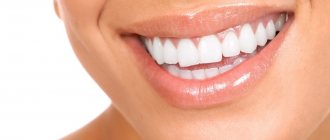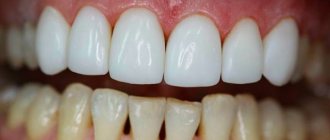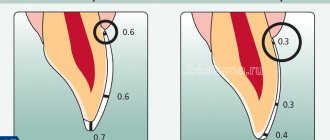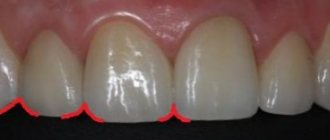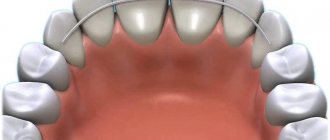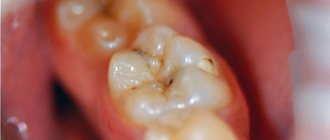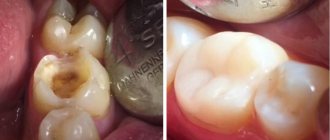If you want to improve the appearance of your smile, if you don’t like something about it, but you cannot accurately and correctly formulate what exactly, if you want to talk with your dentist about the aesthetics of your smile in the same language, then the following note is just right for you.
Nature (or God... depending on your views on life) has made us different. And our originality and uniqueness have its own charm. But what to do when this uniqueness goes too far beyond our ideas of beauty? How to formulate your claims to nature (and perhaps to the previous intervention of dentists)? To assess the aesthetic component of our face, lips, teeth - everything that gives rise to a beautiful, harmonious smile, it turns out that there are many parameters. This is what dentists use (at least should use) when planning changes in your appearance. Since there are very, very many different nuances, and I do not have the task of making each of you an expert in the field of aesthetic dentistry , we will focus on the ten simplest and most important.
Parallelism of horizontal landmarks.
One of the most important signs of a harmonious smile is the parallelism of imaginary lines: the interpupillary line (in the picture there is a blue line connecting the right and left pupil of the eye) and the lip line (in the picture there is a red line drawn between the corners of the mouth).
Both of these lines should also be parallel to the lines connecting the edges of the central incisors (green) and the incisal cusps of the canines (blue)
Gum level.
A smile looks attractive and more aesthetically pleasing , in which the line connecting the necks of the teeth (shown in dotted lines) repeats the line of the upper lip, and the level of gum exposed when smiling is symmetrical on the right and left. At the same time, with a maximally open smile, only the gum “triangles” between the teeth and a small strip of gum above them (no more than 2-3 mm wide) should be noticeable.
Thus, the gums around the upper teeth, upper and lower lips form a kind of frame for your smile. If the “picture” is not visible behind the frame, then such a smile will not look attractive.
Excessive visualization of the gums (the so-called “gummy smile”) is most often eliminated with the help of surgery, orthodontic treatment, as well as cosmetic interventions (for example, Botox injections into the upper lip, upper lip augmentation, etc.).
How much does a perfect smile cost?
The cost of a perfect smile depends on the procedures that will need to be completed to achieve the desired result. If we are talking about hygienic cleaning and whitening, then, depending on the technique and level of the clinic, the price ranges from 10,000 to 37,000 rubles for both services. If we talk about the price of lumineers in Moscow, it starts from 35,000 per tooth. Depending on the material used, the cost of ceramic veneers starts from 3,000 to 50,000 rubles or even more. Orthodontic treatment, prosthetics and implantation are procedures that require taking into account many factors on which the price depends.
Publisher: Expert magazine about dentistry Startsmile.ru
Vertical symmetry and midline.
A line passing through the center of the face should pass exactly between the central incisors of the upper jaw. The discrepancy between these lines causes a feeling of disharmony even with a quick glance at your smile from the outside. In this case, it is not at all necessary that it also passes between the central lower incisors. Firstly, a complete match is rarely found, and secondly, this in no way affects the aesthetic perception of your smile when viewed from the outside.
"Golden proportion".
The principle of the golden proportion in relation to a smile in aesthetic dentistry is that when looking at it from the front strictly in the center, the ratio of the apparent width of the front teeth should be approximately the following - 0.6 (width of the canine): 1 (width of the lateral incisor): 1.6 (width of the central incisor ).
As can be seen in the photo, the width of the visible part of the remaining teeth (4s, 5s) should consistently decrease, creating a sense of perspective.
Crowns made from “IPS E.max” –
IPS E.max materials are metal-free lithium disilicate ceramics intended for the manufacture of crowns and veneers. The E.max material is glass-ceramic, the light transmittance/transparency of which is almost identical to natural tooth enamel. Because of this, lithium disilicate crowns and veneers are sometimes completely indistinguishable from real teeth.
There are 2 main E.max materials for making crowns. Firstly, this is “E.max PRESS”, which is designed for the manufacture of crowns and veneers using injection molding at high temperature and pressure. Let's say right away that this material is the best if you want to make single crowns or veneers, or you need a 3-unit bridge on your front teeth.
Secondly, this is “E.max CAD”, intended for the manufacture of crowns and veneers using the milling method (CAD/CAM technology), so the same method is used here as in the manufacture of zirconium crowns. Compared to E.max PRESS, this material already has slightly less strength and is no longer suitable for the manufacture of bridges and thin veneers. Another disadvantage is that E.max CAD has a much smaller range of material shades, which limits the dental technician’s ability to ensure that the crown actually blends in color with the adjacent teeth.
Clinical case No. 8 (before and after photos) –
Take a look at the before and after photos posted above. In this case, the patient used E.max CAD ceramics, although E.max PRESS ceramics has a significantly larger range of material shades (which provides more opportunities to make the crown invisible against the background of neighboring teeth). But in this case, the patient had crowns made for 10 front teeth at once, and therefore the dental technician was not faced with the task of accurately imitating the color and transparency of the neighboring teeth.
From this we can conclude that if you need to make one or more crowns, it is better to choose E.max PRESS ceramics. If you are going to make crowns for all the front teeth (at least one jaw), then “E.max CAD” ceramics are also suitable.
For more information about the various options for manufacturing zirconium crowns and the rating of manufacturers of zirconium dioxide blocks, read the article: → Options for manufacturing E.max crowns, prices
Proportions of the tooth.
The central incisors of the upper jaw always attract special attention, because... best visible when talking and smiling. Therefore, it is very important that their proportions are correct. The most harmonious looking teeth are those with a ratio of tooth width to length of approximately 0.7-0.8: 1
However, at different ages this ratio may change. Due to the physiological wear of teeth in older age, this ratio tends to be 1:1. Therefore, if you want to “rejuvenate” your smile, you usually need to increase the length of the tooth.
Reasons for the development of malocclusion
Abnormal bite can occur under the influence of the following factors that provoke its development:
- In children: thumb sucking and prolonged use of a pacifier.
- Bad habits such as putting things in your mouth and chewing them.
- The first baby teeth do not fall out for a long time.
- Bruxism.
- Wide gaps between the elements of the dentition.
- Large gaps between teeth.
- Complex respiratory diseases.
- Pathological processes in the body that negatively affect bone development.
- Poorly developed diet without solid food.
- Side effects after prosthetics.
- Loss of most of the elements of the dentition.
Many people with malocclusion often wonder: when is orthodontic intervention necessary to correct the situation? The situation can be corrected only after preliminary diagnostics. In some cases, it is needed if there are no obvious defects. Below we will consider cases when such measures cannot be avoided:
- Direct closure of teeth during physiological occlusion, when it causes increased abrasion of tooth enamel.
- With a progenic bite, a short upper lip makes the upper row of teeth too noticeable, spoiling the aesthetics of the smile.
- If a person has too large front teeth of the correct shape with a progenic or biprognathic bite.
- Impaired diction with mesial occlusion, when the lower jaw of a person is underdeveloped, which contributes to the overlap of the upper front teeth with the lower incisors.
- With open pathology, there is no contact between most of the teeth when the jaws close. The anomaly is classified into lateral and frontal. The treatment method for each form is selected by the orthodontist individually for each patient.
- With deep pathology, tooth enamel is quickly erased due to complete overlap of the lower teeth.
- In a crossbite, one of the jaws is partially unformed. The situation is being corrected through comprehensive measures.
You can determine a person’s correct bite using photographs or by contacting a professional orthodontist.
Interincisal angles.
Interincisal angles are the spaces between the cutting edges of the anterior group of teeth.
With the harmonious construction of teeth, these angles should gradually increase from the center to the periphery: from a small closed angle between the central incisors, to a more direct and even open angle between the 2nd and 3rd teeth.
Tooth wear leads to a decrease or complete absence of interincisal angles, which makes the patient look older when he smiles.
At the same time, “female” teeth are characterized by rounded corners of the incisors, while “male” teeth are characterized by straighter ones.
Zenith of the gingival contour.
The zenith of the gum is its most concave part around the neck of the tooth (indicated by dots in the photo).
The level of zeniths near different teeth in the smile zone should be at different levels. For the central incisors and canines - approximately at the same level (or slightly higher for the canines), for the lateral incisors - slightly lower than both (as shown by the lines in the photo). At the same time, it is equally important that the zeniths on symmetrical teeth are at the same level. This is especially important to consider if this area becomes noticeable when smiling. When even with the most open smile the gums are not exposed, then there is no serious need to set the zeniths perfectly symmetrically.
In this case, attention is drawn to the too low zenith level on tooth 12; it is significantly lower than the symmetrical tooth 22. There is also a slight difference in the position of the zeniths on the central incisors (teeth 11 and 21). As a result of treatment, these shortcomings were eliminated, as can be seen in the first photo.
Which veneers are better for men: composite or ceramic?
Which veneers are better for men: composite or ceramic and why?
There is a huge difference between porcelain and composite veneers.
No one chooses composite veneers now; only those patients who want to save money choose. But now, I repeat, this trend has disappeared altogether, that is, putting on composite veneers is like putting linoleum in the kitchen: you can save on the material, but it’s better not to do this.
How long do veneers last?
In general, I never strive to make composite veneers, since I understand perfectly well that it will turn out to be a complete nightmare, that is, on all fronts (aesthetics, quality, reliability) we will lose threefold. How long do these veneers last? Even if it turns out beautifully, then it will last for a maximum of 5 years, then caries will begin to develop
, and it will be bad. And ceramic veneers are durable; they can last up to 30 years without any problems. Therefore, for me, as an experienced dentist, the question of which veneers are best is not on the agenda.
The disadvantages of composite veneers are obvious
That is, if we are only talking about the shelf life of composite veneers, when we change them, we will have to drill them out along with the caries and repeat the application of the composite again. But it is also possible that these teeth will already have caries at the root, because composite veneers are made at the root level. And, unfortunately, the development of such cervical caries may not be noticed at all, but can only be detected during professional hygiene in dentistry.
Another minus
composite veneers.
Even the best quality composite veneers darken
over time. They cannot be lightened or bleached later. The service life of such veneers is extremely limited.
As you now understand, the desire to save on composite veneers in the short term of 5-7 years can create global dental problems for the patient with all the attendant costs.
Position of cutting edges.
The cutting edges of the central group of teeth are also located at different levels. For the central incisors and canines - approximately at the same level, for the lateral incisors - slightly higher (as marked by lines in the photo).
Again, due to the abrasion of teeth with age, the cutting edges of the teeth become at the same level, the line connecting them takes on a straight rather than convex appearance, and sometimes (with increased pathological abrasion) even concave. Therefore, to make a smile more “youthful,” you need to return the relationship of the cutting edges to a harmonious one.
It can also be noted that the dominance of the central incisors over the lateral incisors and canines also gives the smile a more youthful appearance.
The dominance of the canines, their sharp, prominent cutting cusps, make the smile more aggressive. This effect is based on the fact that in nature, long, sharp, well-developed fangs are characteristic of predators, whose entire philosophy of existence is based on aggression towards their prey.
Interdental gingival papillae.
The gingival papilla is the part of the gum that fills the interdental space (marked with lines in the photo).
The location and appearance of the papillae is determined by the underlying bone, which has exactly the same contour. In the most optimal option, the tops of the gingival papillae are located as in the photo (marked with dots) - between the central incisors the gingival papilla is longest, and gradually its length decreases towards the periphery. Moreover, they should all have a healthy appearance - a triangular shape with a sharp apex, pink color, no swelling.
With various periodontal diseases, as well as with improperly performed restorations, the gingival papilla may become inflamed, acquiring a darker (or even bluish) color, losing its pointed shape, or may even disappear completely. At the same time, unaesthetic black spaces form between the teeth.
This is what the main, but still far from complete, list of parameters that need to be assessed and taken into account when planning and creating an ideal smile looks like. aesthetic dentistry does . Now you can evaluate for yourself how close your smile is to ideal. And I hope that this note will help you better understand what exactly you would like to change and improve. After all, this will greatly facilitate mutual understanding between you and your dentist.
PS See the photographs of clinical cases of my patients presented in this note in detail in the photo gallery section of the site, where details about aesthetic dentistry and modern dental technologies for restoring an ideal smile.
How to get the perfect smile?
The minimum required set for a perfect smile is a toothbrush, toothpaste, floss and visits to the dentist twice a year. Unfortunately, today few people fulfill these requirements, and at a fairly young age people already suffer from diseases of the oral cavity, in which the smile is far from ideal. Even so, dentists use techniques to improve the aesthetics of your smile.
If you are unhappy with your smile, your dentist can help you fix it. First of all, determine what exactly you don't like. Depending on the problem, different treatment methods are used. In some cases, it is enough to do professional oral hygiene; in others, whitening will help.
